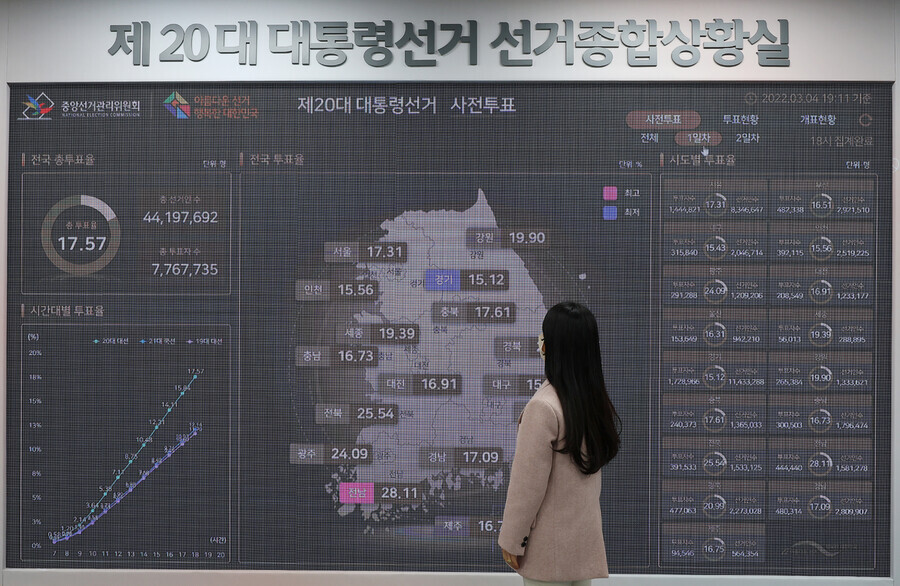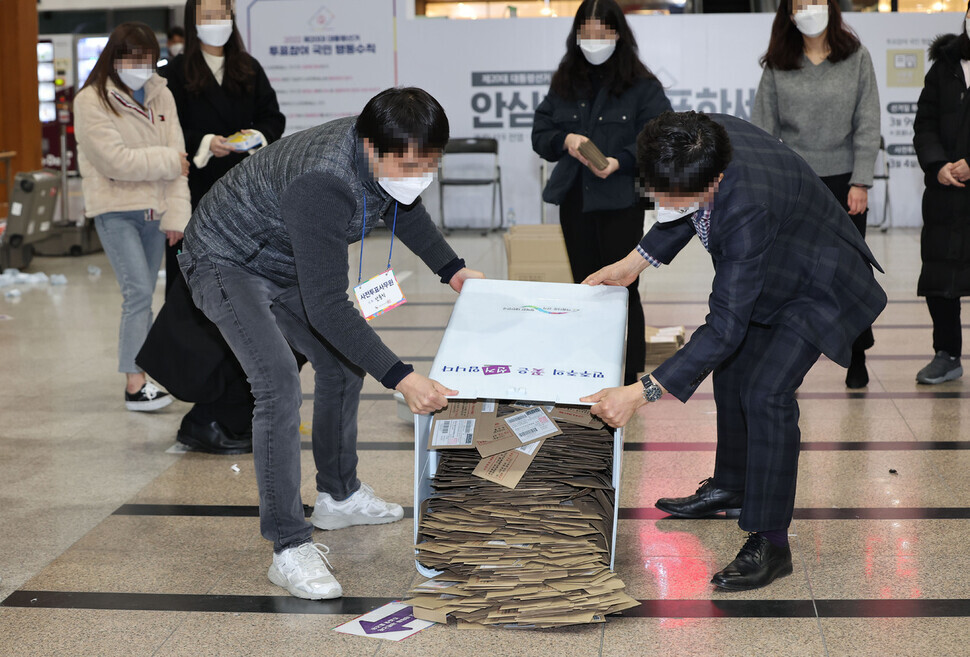hankyoreh
Links to other country sites 다른 나라 사이트 링크
Which candidate stands to benefit from S. Korea’s record 36.93% early voting turnout?

The two-day early voting period for the South Korean presidential election that began on Friday saw a record turnout of 36.93% — the highest the figure has ever been since advance polling was first adopted. While People Power Party candidate Yoon Suk-yeol’s campaign interpreted the high turnout as a result of “voters’ strong desire to put a new party in power,” Democratic Party candidate Lee Jae-myung’s camp concluded the record number is “a sign that supporters from both the opposition and ruling parties are rallying.”
The National Election Commission announced Saturday night that 16,323,602 out of 44,197,692 eligible voters cast their ballot early, resulting in the record turnout of 36.93% — the highest the figure has ever been since early voting was implemented in national elections for the first time during the 2014 local elections.
The previous record of 26.69% was set in the run-up to the 2020 general election. Early voter turnout for the previous presidential election in 2017 was 26.06%, 10.87 percentage points lower than this year’s figure. For this reason, whether the final turnout will exceed 80% for the first time since the 1997 presidential election’s 80.7% has become a source of great interest. In terms of regional turnout, the figure was highest in South Jeolla Province (51.45%), followed by North Jeolla Province (48.63%) and Gwangju (48.27%).
The People Power Party (PPP) is interpreting the unprecedented turnout as a sign of popular consensus for a political turnover and the result of mobilization by voters in their 20s and 30s. Kwon Young-se, who serves as the PPP’s campaign chief, said during a campaign committee meeting on Sunday, “We are thankful for voters’ aspiration to put a new party in power and their subsequent participation in the election.” He continued, “Particularly, voters in their 20s and 30s reportedly formed long lines at early polling stations, and Yoon and our party will bear in mind and never forget the values of fairness and common sense that these voters expect of us.”
Yoon took to Facebook as well, writing, “I am deeply thankful to voters who showed their longing for a new party to take power by turning out to vote in record numbers.” Data for early voting turnout by age group is not available at this time.
The PPP is also optimistic about the high voter turnout in the Honam region that’s made up of North and South Jeolla provinces and Gwangju. That’s because PPP leadership has taken great pains to win over Honam voters with the goal of securing 30% of Honam votes for Yoon. A PPP campaign official said, “Though support for the ruling party is traditionally high in the region, we’ve made a lot of efforts in Honam so far, so we’re hoping to put up a good fight there,” adding, “There’s no way to know the outcome until the results are out.”
Though early voter turnout in Daegu, the backbone of support for the PPP, was 33.91% and significantly lower than the national average, the prevailing view within the PPP is that this can be offset by getting voters to the polls on Wednesday. A PPP lawmaker commented, “Because many of our supporters don’t trust the National Election Commission to hold a clean election, many who didn’t come out for early voting will cast their ballot on the day of the election.” The lawmaker continued, “I believe we will win the election by a landslide.”
On the other hand, the Democratic Party was more cautious in its interpretation of the high voter turnout, saying the turnout for early voting is not a good indicator of voters’ preferences. During a press conference held at the Democratic Party's headquarters in Yeouido, the ruling party’s campaign chief Woo Sang-ho said, “It’s unscientific to determine the likelihood and unlikelihood of victory for specific candidates based on the early voting turnout number when it’s impossible to verify supporters of which side came out to vote at a higher rate,” adding that the record turnout can be considered “no more than a sign that supporters of both the ruling and opposition parties are mobilizing.”
Concerning the high voter turnout in the Honam region, he responded with a question, “Inversely, what about the high voter turnout in Gangwon Province and the Youngnam region?” referring to the north and southwestern corners of the country.
An official with the Democratic Party’s campaign also commented, “In the past, many said a high voter turnout is a sign that the Democratic Party will win, but that’s not the case anymore,” further adding, “Even if early voting took place in high numbers in Honam, that doesn’t mean all those votes were cast for the Democratic Party. For this year’s election, we can’t know the outcome until all votes are counted.”
Still, Woo said the tables are turning in the race to the Blue House, stating that “the surprise opposition campaign merger that threw a big variable at the last minute is prompting backlash.” He explained, “In female-centered online communities, reactions along the line of ‘Yoon Suk-yeol of all people shouldn’t be the president’ are surfacing, suggesting that voters are changing their mind, and male voters in their 20s and 30s who supported Ahn Cheol-soo are calling the opposition campaign merger ‘unacceptable’ and moving over to Lee’s side.”

Others say the strong early voter turnout is not so unprecedented, as the figure has been consistently high in previous elections. Park Sung-min, president of the political consultancy Min Consulting, said, “The extent of the meaning behind [the high early voter turnout] is that supporters of both the ruling and opposition parties are mobilizing.”
He continued, “Still, considering that the consensus for a political turnover was stronger than the consensus for the ruling party to stay in power in the last opinion poll [before the poll blackout period], a higher voter turnout may prove favorable for Yoon. On the other hand, if voter turnout is significantly higher in Honam and among voters in their 40s, who support Lee at a higher rate, then the situation may prove favorable for Lee.”
Kyung Hee University professor Kim Yoon-cheol also commented, “With competition intensifying at the last minute, candidates on both sides have encouraged voters to turn up to polls, which translated into voters casting their ballot solely based on their preference.”
He added, “Because it’s hard to say that moderates and undecided voters who haven’t voted yet will cast their ballots in a way that would be undeniably favorable to one side, [the high voter turnout] can’t be interpreted as an auspicious sign for one side or the other.”
By Lee Jae-hoon, staff reporter; Jang Na-rye, staff reporter; Choi Ha-yan, staff reporter; Bae Ji-hyun, staff reporter
Please direct questions or comments to [english@hani.co.kr]

Editorial・opinion
![[Editorial] Yoon must halt procurement of SM-3 interceptor missiles [Editorial] Yoon must halt procurement of SM-3 interceptor missiles](https://flexible.img.hani.co.kr/flexible/normal/500/300/imgdb/child/2024/0501/17145495551605_1717145495195344.jpg) [Editorial] Yoon must halt procurement of SM-3 interceptor missiles
[Editorial] Yoon must halt procurement of SM-3 interceptor missiles![[Guest essay] Maybe Korea’s rapid population decline is an opportunity, not a crisis [Guest essay] Maybe Korea’s rapid population decline is an opportunity, not a crisis](https://flexible.img.hani.co.kr/flexible/normal/500/300/imgdb/original/2024/0430/9417144634983596.jpg) [Guest essay] Maybe Korea’s rapid population decline is an opportunity, not a crisis
[Guest essay] Maybe Korea’s rapid population decline is an opportunity, not a crisis- [Column] Can Yoon steer diplomacy with Russia, China back on track?
- [Column] Season 2 of special prosecutor probe may be coming to Korea soon
- [Column] Park Geun-hye déjà vu in Yoon Suk-yeol
- [Editorial] New weight of N. Korea’s nuclear threats makes dialogue all the more urgent
- [Guest essay] The real reason Korea’s new right wants to dub Rhee a founding father
- [Column] ‘Choson’: Is it time we start referring to N. Korea in its own terms?
- [Editorial] Japan’s rewriting of history with Korea has gone too far
- [Column] The president’s questionable capacity for dialogue
Most viewed articles
- 1Months and months of overdue wages are pushing migrant workers in Korea into debt
- 2[Guest essay] Maybe Korea’s rapid population decline is an opportunity, not a crisis
- 3Dermatology, plastic surgery drove record medical tourism to Korea in 2023
- 4Under conservative chief, Korea’s TRC brands teenage wartime massacre victims as traitors
- 5At heart of West’s handwringing over Chinese ‘overcapacity,’ a battle to lead key future industries
- 6Trump asks why US would defend Korea, hints at hiking Seoul’s defense cost burden
- 7First meeting between Yoon, Lee in 2 years ends without compromise or agreement
- 81 in 3 S. Korean security experts support nuclear armament, CSIS finds
- 9[Editorial] Yoon must halt procurement of SM-3 interceptor missiles
- 10Fruitless Yoon-Lee summit inflames partisan tensions in Korea